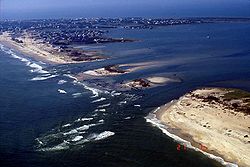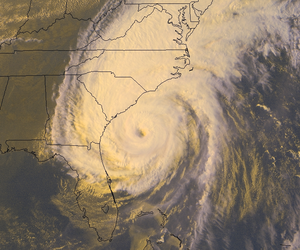- List of North Carolina hurricanes
-
Hurricane Floyd ten hours prior to its North Carolina landfall; Floyd caused the worst modern disaster in the state[1]

The list of North Carolina hurricanes includes 403 known tropical or subtropical cyclones that have affected the U.S. state of North Carolina. Due to its location, many hurricanes have hit the state directly, and numerous hurricanes have passed near or through North Carolina in its history; the state is ranked fourth, after Florida, Texas, and Louisiana, in the number of cyclones that produced hurricane force winds in a U.S. state.[2][3] Hurricanes in North Carolina history are responsible for over $11 billion in damage (2008 USD) and almost 1,000 total fatalities.
Contents
Climatology
As to statistical hurricane research between 1886 and 1996 by the North Carolina State Climatology Office, a tropical cyclone makes landfall along the coastline about once every four years. An estimated 17.5 percent of all North Atlantic tropical cyclones have affected the state.[4] Additionally, the remnants of a few Pacific tropical cyclones struck the state.[5] Cape Hatteras is most affected by storms within the state, though Cape Lookout and Cape Fear are also regularly affected; the increased activity in three areas is because it protrudes from elsewhere along the Atlantic coastline.[4] After Southern Florida, Cape Hatteras has the lowest return period, or the frequency at which a certain intensity or category of hurricane can be expected within 86 mi (139 km) of a given location, in the country.[6] As the Outer Banks are a narrow strip of low-lying land, hurricanes occasionally leave portions of the land partially or fully submerged.[7] Additionally, the remnants of inland tropical cyclones have produced flooding and landslides in the state's western region.[8]
Tropical cyclones have affected North Carolina in every month between May and December; about 35 percent of the storms struck the state in September, and 80 percent affected the state between August and October, which coincides with the peak of the hurricane season. The earliest storm to affect the state was Subtropical Storm Andrea on May 7, 2007, and the latest was a tropical storm that moved across the Outer Banks on December 2, 1925. The strongest storm to strike the state was Hurricane Hazel in 1954, which made landfall as a Category 4 hurricane on the Saffir-Simpson Hurricane Scale.[9]
Pre-1900
 Topographic map of North Carolina
Topographic map of North Carolina Main article: List of North Carolina hurricanes (pre-1900)
Main article: List of North Carolina hurricanes (pre-1900)The list of North Carolina hurricanes before 1900 encompasses 139 tropical cyclones that affected the U.S. state of North Carolina. Collectively, cyclones in North Carolina during the time period resulted in over 775 direct fatalities during the period. Seven cyclones affected the state in the 1893 season, which was the year with the most tropical cyclones devastating the state during the time period. From the beginning of the official Atlantic hurricane record in 1851 to 1899, there were 12 years without a known tropical cyclone affecting the state.
Historical data prior to 1700 is sparse due to lack of significant European settlements along the coastline; the few storms listed are largely records from Roanoke Colony and later the Province of Carolina. Modern meteorologists believe early storms were tropical cyclones, though due to the time period confirmation is impossible.[10] One theory explaining the disappearance of Roanoke Colony suggests a hurricane destroyed the village, though there is no evidence to prove the theory. It is considered unlikely due to lack of damage to a fence around the village, on which the villagers left an inscription.[11]
1900–1949
 Damage from 1933 Outer Banks hurricane
Damage from 1933 Outer Banks hurricane Main article: List of North Carolina hurricanes (1900–1949)
Main article: List of North Carolina hurricanes (1900–1949)Between 1900 and 1949, 75 tropical cyclones or their remnants affected the state. Collectively, cyclones in North Carolina during that time period resulted in 53 total fatalities during the period, as well as about $328 million in damage (2008 USD). Tropical cyclone affected the state in all but nine seasons. In the 1916 season, five storms affected the state, which was the season with the most storms devastating the state. The strongest hurricanes to affect the state during the time period were the 1933 Outer Banks hurricane and the 1944 Great Atlantic Hurricane, which produced winds of Category 3 status on the Saffir-Simpson Hurricane Scale within the state.[2] The 1933 Outer Banks hurricane was the deadliest hurricane in the state during the time period, which killed 21 people.[12] The remnants of a hurricane in 1940 dropped heavy rainfall in the state, which caused over $150 million in damage (2008 USD) from flooding and landslides.[13]
1950–1979
 Radar image of Hurricane Connie near North Carolina
Radar image of Hurricane Connie near North Carolina Main article: List of North Carolina hurricanes (1950–1979)
Main article: List of North Carolina hurricanes (1950–1979)A total of 79 tropical or subtropical cyclones affected North Carolina between 1950 and 1979. Collectively, cyclones during the time period resulted in 37 total fatalities during the period, as well as about $3 billion in damage (2008 USD). A cyclone affected the state in every year during the time period, and in three seasons a total of five cyclones assailed the state. The strongest hurricane to hit the state during the time period was Hurricane Hazel, which struck the state as a Category 4 hurricane on the Saffir-Simpson Hurricane Scale. Hazel was both the costliest and deadliest cyclone during the period, causing over $1 billion in damage (2008 USD) and 19 deaths.[14] Most storms affected the state in September, though cyclones lashed the state between May and October.
1980–Present
 New inlet created by Hurricane Isabel (USGS)
New inlet created by Hurricane Isabel (USGS) Main articles: List of North Carolina hurricanes (1980–1999) and List of North Carolina hurricanes (2000–present)
Main articles: List of North Carolina hurricanes (1980–1999) and List of North Carolina hurricanes (2000–present)The period from 1980 to the present encompasses 110 tropical or subtropical cyclones that affected the state. Collectively, cyclones in North Carolina during the time period resulted in over $10 billion in damage (2010 USD), primarily from hurricanes Fran and Floyd. Additionally, tropical cyclones in North Carolina were responsible for 77 direct fatalities and at least 44 indirect casualties during the period. Eight cyclones affected the state in the 1985 season, which was the year with the most tropical cyclones striking the state. Every year included at least one tropical cyclone affecting the state.
The strongest hurricane to hit the state during the time period was Hurricane Fran in 1996, which struck near Wilmington as a Category 3 hurricane on the Saffir-Simpson Hurricane Scale; Hurricane Emily in 1993 brushed the Outer Banks also as a Category 3 hurricane.[2] The deadliest hurricane during the period was Hurricane Floyd in 1999, which caused 35 fatalities and record–breaking flooding in the eastern portion of the state.[15][16]
North Carolina major hurricanes
The following major hurricanes either made landfall on the state or brought winds of Category 3 status to the state. Storms are listed since 1851, which is the official start of the Atlantic hurricane database.[2]
Storm Saffir-Simpson
CategoryDate of landfall Year Landfall intensity
(in knots)Landfall location Unnamed 3 August 19 1879 100 Cape Lookout San Ciriaco 3 August 18 1899 105 Hatteras Unnamed 3 September 16 1933 100 Ocracoke Great Atlantic Hurricane 3 September 14 1944 100 Cape Hatteras Hurricane Hazel 4 October 15 1954 115 Near South Carolina/
North Carolina borderHurricane Connie 3 August 12 1955 100 Portsmouth Hurricane Ione 3 September 19 1955 100 Morehead City Hurricane Helene 3 September 27 1958 100 Offshore Outer Banks Hurricane Donna 3 September 12 1960 100 Emerald Isle Hurricane Diana 3 September 13 1984 100 Cape Fear Hurricane Gloria 3 September 27 1985 100 Hatteras Island Hurricane Emily 3 August 31 1993 100 Offshore Hatteras Island Hurricane Fran 3 September 6 1996 100 Cape Fear Hurricane Irene Hit NC as category 1 but was disastrous in August 27-28
Climatological statistics
Month Number of recorded storms
affecting North CarolinaMay 8 June 28 July 34 August 101 September 142 October 80 November 9 December 1 
Period Number of recorded storms
affecting North CarolinaPre–18th century 9 18th century 22 1800–1809 4 1810s 3 1820s 8 1830s 10 1840s 7 1850s 12 1860s 8 1870s 12 1880s 23 1890s 21 1900–1909 14 1910s 17 1920s 12 1930s 15 1940s 17 1950s 24 1960s 23 1970s 32 1980s 32 1990s 36 2000–2008 39 
Deadly storms
The table lists hurricanes by death tolls of over 20 fatalities. Direct deaths are those that are directly caused by the storm passage, such as drownings or deaths from being struck by windblown objects. Indirect deaths, which are included in the toll of Hurricane Floyd, are those that are related to the storm, but not directly from its storm effects. Due to lack of data, many early hurricanes have overall death tolls that do not specify indirect or direct.
Total deaths Name Year Number of deaths "San Ciriaco" 1899 20+ "Outer Banks Hurricane" 1933 21 Unnamed 1772 50 Hurricane Floyd 1999 51 Unnamed 1883 53 "Racer's Storm" 1837 90 "Independence Hurricane" 1775 163 Unnamed 1857 424 See also
- Climate of North Carolina
- Geography of North Carolina
- List of United States hurricanes
- List of wettest known tropical cyclones in North Carolina
- List of Atlantic hurricanes
North Carolina hurricanes References
- ^ Federal Emergency Management Agency (2000). "Approaching One Year, North Carolina Floyd Assistance More Than $1.9 Billion". http://www.fema.gov/news/newsrelease.fema?id=9089. Retrieved 2007-12-14.
- ^ a b c d Hurricane Research Division (2008). "Chronological List of All Hurricanes which Affected the Continental United States: 1851-2005". National Oceanic and Atmospheric Administration. http://www.aoml.noaa.gov/hrd/hurdat/ushurrlist18512007.txt. Retrieved 2008-04-03.
- ^ Hurricane Research Division (2006). "Documentation of Atlantic Tropical Cyclones Changes in HURDAT". National Oceanic and Atmospheric Administration. http://www.aoml.noaa.gov/hrd/hurdat/metadata_master.html. Retrieved 2008-01-31.
- ^ a b State Climate Office of North Carolina (2006). "Hurricanes in North Carolina". http://www.nc-climate.ncsu.edu/print/8. Retrieved 2008-04-03.
- ^ David Roth (2008). "Tropical Cyclone Rainfall for the Southeast". Hydrometeorological Prediction Center. http://www.hpc.ncep.noaa.gov/tropical/rain/tcsoutheast.html. Retrieved 2008-04-03.
- ^ National Hurricane Center (2006). "Tropical Cyclone Climatology". http://www.nhc.noaa.gov/pastprofile.shtml. Retrieved 2007-10-02.
- ^ Sprol.com (2005-09-15). "When will a Category Five Hurricane strike the Outer Banks?". http://www.sprol.com/?p=259. Retrieved 2008-03-04.
- ^ William Haggard, Thaddeus Bilton, and Harold Crutcher (1973). "Maximum Rainfall from Tropical Cyclone Stems which Cross the Appalachians" (PDF). Journal of Applied Meteorology. http://ams.allenpress.com/archive/1520-0450/12/1/pdf/i1520-0450-12-1-50.pdf. Retrieved 2008-03-23.[dead link]
- ^ Hurricane Research Division (2007). "Atlantic hurricane best track". NOAA. http://www.aoml.noaa.gov/hrd/hurdat/easyhurdat_5107.html. Retrieved 2008-04-03.
- ^ James E. Hudgins (2000). "Tropical Cyclones Affecting North Carolina since 1566 - An Historical Perspective". Blacksburg, Virginia National Weather Service. Archived from the original on 2007-03-11. http://web.archive.org/web/20070311045226/http://repository.wrclib.noaa.gov/cgi/viewcontent.cgi?article=1002&context=nws_tech_memos. Retrieved 2007-12-18.
- ^ Jarid Goodman. "The Lost Colony of Roanoke, 1588". http://theshadowlands.net/roanoke.htm. Retrieved 2007-12-18.
- ^ Mary Souder (1933). "Severe Local Storms, September 1933" (PDF). U.S. Weather Bureau. http://docs.lib.noaa.gov/rescue/mwr/061/mwr-061-09-0291.pdf. Retrieved 2008-03-28.
- ^ Millsboro Daily News (1940-08-16). "Floods Surge Toward Surge". http://www.thehurricanearchive.com/Viewer.aspx?img=51700375_clean&firstvisit=true&src=search¤tResult=4¤tPage=0. Retrieved 2008-03-23.
- ^ NOAA Coastal Services Center (1999). "New Hanover County, North Carolina Case Study on Hurricane Hazel". http://www.csc.noaa.gov/products/nchaz/htm/hazel.htm. Retrieved 2008-02-16.
- ^ U.S. Department of Commerce (2000). "Hurricane Floyd Floods of September 1999" (PDF). NOAA. http://www.weather.gov/om/assessments/pdfs/floyd.pdf. Retrieved 2007-12-13.
- ^ National Climatic Data Center (1999). "Climate-Watch, September 1999". http://lwf.ncdc.noaa.gov/oa/climate/extremes/1999/september/extremes0999.html. Retrieved 2007-12-22.
List of United States hurricanes United States Arizona · California · Delaware · Florida (pre-1900 · 1900–1949 · 1950–1974 · 1975–1999 · 2000–present) · Hawaii · Maryland (1950–1979 · 1980–present) · New England · New Jersey · New York · North Carolina (pre-1900 · 1900–1949 · 1950–1979 · 1980–1999 · 2000–present) · Pennsylvania · Texas (pre-1900 · 1900–1943 · 1944–1979 · 1980–present)
Categories:- Atlantic hurricanes
- Lists of tropical cyclones by area
- Hurricanes in North Carolina
Wikimedia Foundation. 2010.

